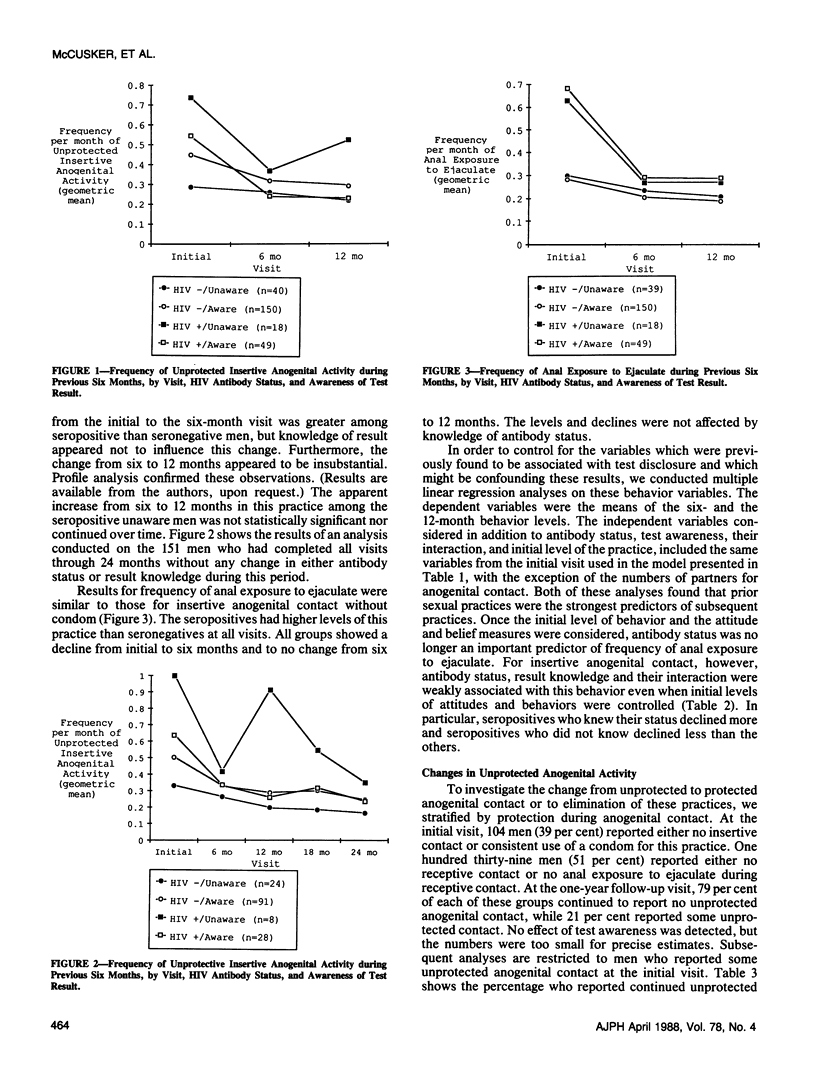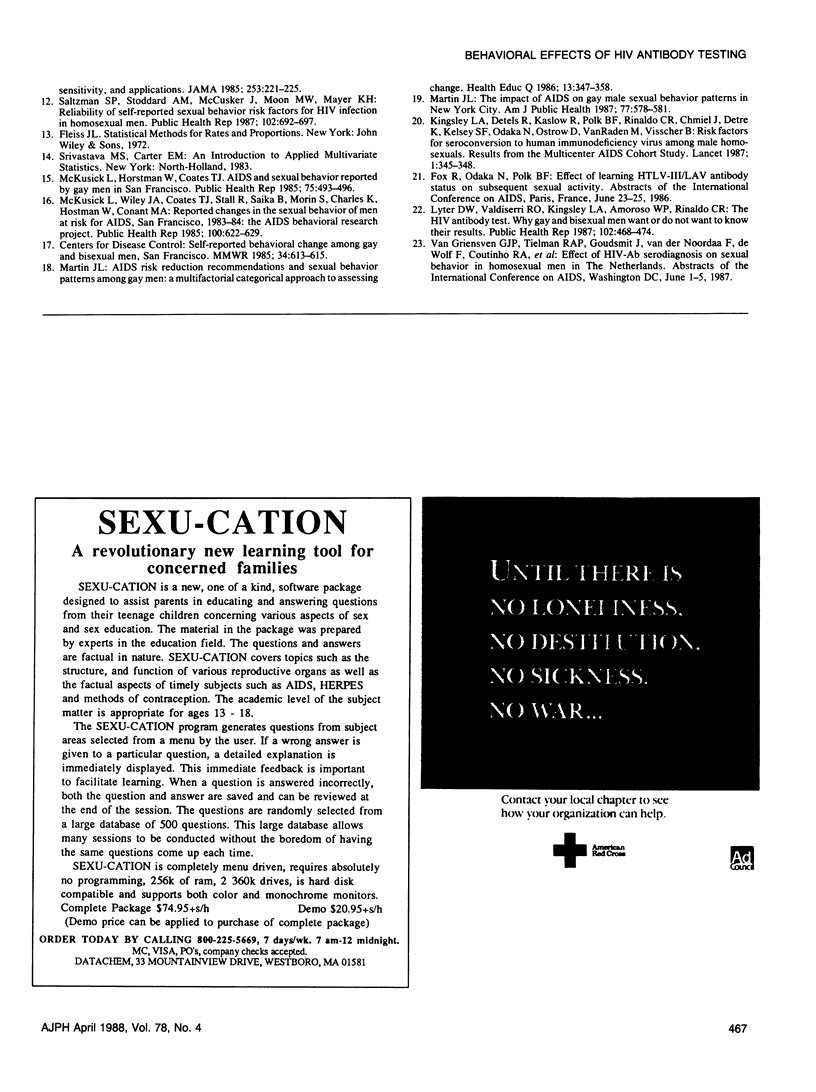Abstract
This study assesses the effects of HIV (human immunodeficiency virus) antibody testing on subsequent (one year) sexual behavior among 270 homosexual men at a Boston community health center, 21 per cent of whom were unaware of their test result. Except for the number of steady partners, the levels of all sexual activities of all groups of study participants declined over time. No effects of test awareness of antibody status were found on protective behavior for receptive anogenital contact. Elimination of unprotected insertive anogenital contact (by elimination of the practice or by condom use) was reported somewhat more often among seropositive men who became aware of their test result. Increased negative emotional reactions were reported by HIV seropositive men who were aware of their test result. These results suggest some behavioral impact of HIV antibody test knowledge in this cohort, but may not be generalizable to other populations.
Full text
PDF





Selected References
These references are in PubMed. This may not be the complete list of references from this article.
- Cooper D. A., Gold J., Maclean P., Donovan B., Finlayson R., Barnes T. G., Michelmore H. M., Brooke P., Penny R. Acute AIDS retrovirus infection. Definition of a clinical illness associated with seroconversion. Lancet. 1985 Mar 9;1(8428):537–540. doi: 10.1016/s0140-6736(85)91205-x. [DOI] [PubMed] [Google Scholar]
- Groopman J. E., Chen F. W., Hope J. A., Andrews J. M., Swift R. L., Benton C. V., Sullivan J. L., Volberding P. A., Sites D. P., Landesman S. Serological characterization of HTLV-III infection in AIDS and related disorders. J Infect Dis. 1986 Apr;153(4):736–742. doi: 10.1093/infdis/153.4.736. [DOI] [PubMed] [Google Scholar]
- Groopman J. E., Mayer K. H., Sarngadharan M. G., Ayotte D., Devico A. L., Finberg R., Sliski A. H., Allan J. D., Gallo R. C. Seroepidemiology of human T-lymphotropic virus type III among homosexual men with the acquired immunodeficiency syndrome or generalized lymphadenopathy and among asymptomatic controls in Boston. Ann Intern Med. 1985 Mar;102(3):334–337. doi: 10.7326/0003-4819-102-3-334. [DOI] [PubMed] [Google Scholar]
- Ho D. D., Sarngadharan M. G., Resnick L., Dimarzoveronese F., Rota T. R., Hirsch M. S. Primary human T-lymphotropic virus type III infection. Ann Intern Med. 1985 Dec;103(6 ):880–883. doi: 10.7326/0003-4819-103-6-880. [DOI] [PubMed] [Google Scholar]
- Kingsley L. A., Detels R., Kaslow R., Polk B. F., Rinaldo C. R., Jr, Chmiel J., Detre K., Kelsey S. F., Odaka N., Ostrow D. Risk factors for seroconversion to human immunodeficiency virus among male homosexuals. Results from the Multicenter AIDS Cohort Study. Lancet. 1987 Feb 14;1(8529):345–349. doi: 10.1016/s0140-6736(87)91725-9. [DOI] [PubMed] [Google Scholar]
- Lyter D. W., Valdiserri R. O., Kingsley L. A., Amoroso W. P., Rinaldo C. R., Jr The HIV antibody test: why gay and bisexual men want or do not want to know their results. Public Health Rep. 1987 Sep-Oct;102(5):468–474. [PMC free article] [PubMed] [Google Scholar]
- Martin J. L. AIDS risk reduction recommendations and sexual behavior patterns among gay men: a multifactorial categorical approach to assessing change. Health Educ Q. 1986 Winter;13(4):347–358. doi: 10.1177/109019818601300406. [DOI] [PubMed] [Google Scholar]
- Martin J. L. The impact of AIDS on gay male sexual behavior patterns in New York City. Am J Public Health. 1987 May;77(5):578–581. doi: 10.2105/ajph.77.5.578. [DOI] [PMC free article] [PubMed] [Google Scholar]
- Mayer K. H., Falk L. A., Paul D. A., Dawson G. J., Stoddard A. M., McCusker J., Saltzman S. P., Moon M. W., Ferriani R., Groopman J. E. Correlation of enzyme-linked immunosorbent assays for serum human immunodeficiency virus antigen and antibodies to recombinant viral proteins with subsequent clinical outcomes in a cohort of asymptomatic homosexual men. Am J Med. 1987 Aug;83(2):208–212. doi: 10.1016/0002-9343(87)90686-3. [DOI] [PubMed] [Google Scholar]
- Mayer K. H., Stoddard A. M., McCusker J., Ayotte D., Ferriani R., Groopman J. E. Human T-lymphotropic virus type III in high-risk, antibody-negative homosexual men. Ann Intern Med. 1986 Feb;104(2):194–196. doi: 10.7326/0003-4819-104-2-194. [DOI] [PubMed] [Google Scholar]
- McCusker J., Stoddard A. M., Mayer K. H., Cowan D. N., Groopman J. E. Behavioral risk factors for HIV infection among homosexual men at a Boston community health center. Am J Public Health. 1988 Jan;78(1):68–71. doi: 10.2105/ajph.78.1.68. [DOI] [PMC free article] [PubMed] [Google Scholar]
- McKusick L., Horstman W., Coates T. J. AIDS and sexual behavior reported by gay men in San Francisco. Am J Public Health. 1985 May;75(5):493–496. doi: 10.2105/ajph.75.5.493. [DOI] [PMC free article] [PubMed] [Google Scholar]
- McKusick L., Wiley J. A., Coates T. J., Stall R., Saika G., Morin S., Charles K., Horstman W., Conant M. A. Reported changes in the sexual behavior of men at risk for AIDS, San Francisco, 1982-84--the AIDS Behavioral Research Project. Public Health Rep. 1985 Nov-Dec;100(6):622–629. [PMC free article] [PubMed] [Google Scholar]
- Safai B., Sarngadharan M. G., Groopman J. E., Arnett K., Popovic M., Sliski A., Schüpbach J., Gallo R. C. Seroepidemiological studies of human T-lymphotropic retrovirus type III in acquired immunodeficiency syndrome. Lancet. 1984 Jun 30;1(8392):1438–1440. doi: 10.1016/s0140-6736(84)91933-0. [DOI] [PubMed] [Google Scholar]
- Saltzman S. P., Stoddard A. M., McCusker J., Moon M. W., Mayer K. H. Reliability of self-reported sexual behavior risk factors for HIV infection in homosexual men. Public Health Rep. 1987 Nov-Dec;102(6):692–697. [PMC free article] [PubMed] [Google Scholar]


